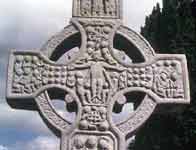There were some 60 Gaelic chieftainships in medieval Ireland, ranging in area from a single barony up to the dominion of The Great O'Neill, whose authority extended over three to nine counties depending on his political fortunes. In the north and west, modern Irish counties approximately reflect territories of the more powerful chieftains in the 16th century, with lesser chiefs holding baronies within these county areas as vassals of the greater chiefs, following their overlord's 'foreign policy' and rendering him military service. In border regions between the spheres of influence of two paramount chiefs, these often competed for the allegiance of individual sub-chiefs, bribing or terrorising them into joining one side or the other. English governors similarly competed with O'Neill for control of chieftains on the borders of the English Pale, such as O'Reilly, MacMahon and O'Hanlon.
http://www.bbc.co.uk/history/war/plantation/ireland_before/index.shtml
Brehon law was based on private arbitration of disputes by a hereditary caste of professional judges, the Brehons. They simply judged the amount of fines due from those guilty, and left it to extended families, patrons or chiefs to enforce payment. Their judgements were based on customary law - preserved in old Irish law tracts of the seventh to the ninth centuries - on case law, and on proclamations of the local ruler. Chiefs employed official Brehons to try cases involving their own interests, appeals from a lower court, and fines for disobedience and tax evasion. By the 16th century, the lord's Brehon also tried public cases of murder and theft.
http://www.bbc.co.uk/history/war/plantation/ireland_before/ib02.shtml

The religious system
Once I asked about their faith, and what they believed in, but they were not at all pleased by the question and I had to stop. They said that they believed in God and the Trinity, just the same as us, with no difference whatever'. This conversation - reported by the chronicler Froissart - between a 14th century Anglo-Irish squire and some leading Gaelic chieftains showed extraordinary misunderstanding, since the Anglo-Normans - after their invasion of Ireland - had enthusiastically adopted the cult of Irish saints such as Patrick and Brigid, and both communities belonged to the same organised church, under the primacy of the archbishop of Armagh.
http://www.bbc.co.uk/history/war/plantation/ireland_before/ib03.shtml
Gaelic Ulster was the most rural part of Ireland. There was some trading at the port of Derry and the harbour at Donegal, at Armagh and at the small market town of Cavan, founded by O'Reilly in the 15th century, and later at Dungannon, where O'Neill had his chief castle. It was also the area with most emphasis on pastoral farming, with whole villages leaving their winter fields where the crops had been sown, to transfer their families and cattle to areas of rough summer grazing in the hills from May to November. There they lived in settlements of temporary huts called in Ireland booleys (Irish 'buaile', 'cattle-pound') in Scotland 'shielings', where they made butter and cheese and other dairy products such as 'bonnyclabber' or soured milk. The men temporarily travelled back to the winter village at harvest-time to save the crops.
http://www.bbc.co.uk/history/war/plantation/ireland_before/ib05.shtml